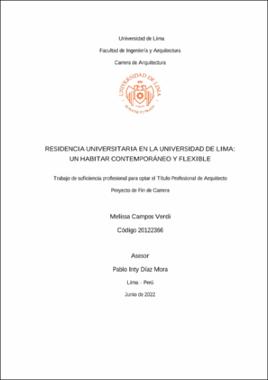Residencia universitaria en la Universidad de Lima: un habitar contemporáneo y flexible

View/
Descargar
(application/pdf: 20.41Mb)
(application/pdf: 20.41Mb)
Date
2022Author(s)
Advisor(s)
Metadata
Show full item recordAbstract
El proyecto se trata de la Residencia Universitaria para la Universidad de Lima como respuesta a los nuevos lineamientos y necesidades actuales de la comunidad universitaria. Se fortalecerían las relaciones interpersonales de sus usuarios, asegurando un sentimiento de pertenencia, de mejor calidad de vida, intercambio intercultural y de información, y de este modo mejorar el proceso global de aprendizaje de sus estudiantes. Asimismo, con ello se mejoraría la calidad de “Vida Estudiantil” como respuesta a la propuesta de expansión del nuevo plan maestro de la universidad. La vida universitaria no se compone únicamente de actividades educativas de enseñanza e investigación, sino que participa de un variado y amplio sistema de relaciones e interdependencias entre áreas de ocio, movilidad, alojamiento, trabajo e intercambio cultural. Se relaciona a la residencia con la universidad, entendiéndolas como un conjunto que no debe de ser tomado por separado y menos aun cuando se proyecta al futuro, sino analizar las relaciones espaciales entre una y otra. Se dice que solo a través de estos intercambios de información y de formas de relacionarse se puede lograr el correcto habitar de los estudiantes. De este modo, surgió mi interés por investigar el habitar, el nomadismo y sedentarismo, los espacios intermedios, en especial en relación a ejemplos de obras del estructuralismo, y a los límites y conexiones. Además, se analizaron antecedentes históricos y contemporáneos de residencias en el mundo, Latinoamérica y Perú, así como referentes proyectuales, el modo de emplazamiento habitual de las residencias en el mundo y el aforo que suelen suplir en diferentes países, entre otras tendencias. El crecimiento exponencial de demanda por educación superior universitaria que se generó en los últimos años en Perú, y que fue directamente proporcional con el crecimiento en oferta educativa en el país, creció a la par con la alta demanda de alojamiento que esto conllevó, pero no con la oferta que se requirió para suplirla, generando una gran brecha en el sistema. De este modo, la Residencia funcionará como uso mixto, abasteciendo a 4 usuarios diversos (estudiantes de pregrado, posgrado, intercambio y docentes), bajo una distribución equitativa que fomenta como objetivo principal a la comunidad, y con un programa comercial para la ciudad y los vecinos del barrio residencial que la rodea. En otras palabras, áreas dedicadas al público en general, áreas que la Universidad de Lima aún no tiene. A nivel urbano, el proyecto se vuelve la primera aproximación de parte de la Universidad por una relación con la sociedad y ciudad en la que se encuentra. Se vuelve el primer problema de desarrollo urbano que se debe resolver para restablecer la conexión entre la universidad, el alojamiento universitario y la ciudad, dada la capacidad de influencia y poder ejemplarizante que abarcan las residencias en el marco urbano y social del entorno que lo rodea. The project is about the Residence for the “Universidad de Lima”, as a response to the new guidelines and current needs of the university’s community. The interpersonal relationships of its users would be strengthened, ensuring a feeling of belonging, better quality of life, intercultural exchange and information, and thus improve the global learning process of its students. Likewise, this would improve the quality of “Student Life” in response to the proposed plan of expansion according to the new Master Plan. University life is not only made up of educational activities regarding teaching and research, but also participates in a varied and extensive system of relationships and interdependencies between areas of leisure, mobility, accommodation, work and cultural exchange. The residence is related to the university, and so, they should both be considered as a whole, as a set that should not be taken separately. It is said that only through these exchanges of information and ways of relating can the correct habitat of students be achieved. This is how my interest arose to investigate the new ways of living (“el habitar”), nomadism and sedentarism, intermediate spaces, especially in relation to examples of structuralism projects, and theories regarding limits and connections. In addition, historical and contemporary antecedents of residences in the world, Latin America and Peru were analyzed, as well as the settlement trends for residences worldwide, and the capacity that they usually supply in different countries for each type of user, among others. The exponential growth in demand for higher education that was generated in recent years in Peru, and which was directly proportional to the growth in educational supply in the country, grew along with the high demand for accommodation that this entailed, but not with the supply that was required, generating a large gap in the system. In this way, the Residence will function as a mixed use, supplying 4 diverse users (undergraduate, postgraduate, exchange students and teachers), under an equitable distribution that promotes the community as its main objective, and with a commercial program for the city and the residents of the neighborhood that surrounds it. In other words, areas dedicated to the general public, areas that the “Universidad de Lima” does not yet have. At a urban level, the project becomes the first approximation from the University to
establish a relationship with the society and city in which it is located. It becomes the first urban development problem that must be solved to reestablish the connection between the University, the Residence and the city, given the capacity of influence and exemplary power that the residences encompass in the urban and social framework of the surrounding environment.
How to cite
Campos Verdi, M. (2022) Residencia universitaria en la Universidad de Lima: un habitar contemporáneo y flexible [Trabajo de suficiencia profesional para optar el Título Profesional de Arquitecto, Universidad de Lima]. Repositorio Institucional de la Universidad de Lima. https://hdl.handle.net/20.500.12724/16319Publisher
Universidad de LimaSubject
Collections
The following license files are associated with this item:

